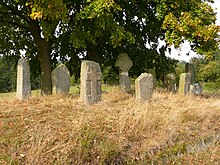Cross stone
A cross stone is a hall monument that consists of an upright stone slab with a raised or carved cross .
description
The cross stone differs from a stone cross in that the stone is not completely carved in the shape of a cross. Disc cross stones are shaped in the upper half as a round disc with a cross. Wheel cross stones are also upright stone slabs in disc shape with openings in circular sectors.
Cross stones were erected in the Middle Ages , especially between the 13th and 16th centuries, as legal monuments at places where people who had died in an accident or were slain without being able to receive the sacraments beforehand . Violent crimes, they were often the culprit for a reparation agreement as a penitential cross erected.
Stone markings such as stone crosses and cross stones were built from local stone ( basalt , limestone or sandstone ) in addition to their use as atonement stones as well as boundary marks in the Middle Ages and in the early modern period .
Special forms are cross slabs in the British Isles or kachkars in Armenia.
Well-known cross stones
- List of stone crosses and cross stones in the Elbe-Elster district
- List of stone crosses and cross stones in the Oberspreewald-Lausitz district
- Siebenmännerstein
- Kreuzstein (Meinheim) , Weissenburg-Gunzenhausen district
Individual evidence
- ^ Organizational groups according to Heinrich Riebeling: Flurdenkmale - inventory guidelines. 1972. here online at sühnekreuz.de
- ^ Christian Wiegand: Searching for traces in Lower Saxony: Discovering historical cultural landscapes. Schlütersche Verlagsgesellschaft, 2005, p. 210. online here
- ^ Harald Kröber: Nature and landscape in Lower Saxony. The natural monument types. Schlütersche Verlagsgesellschaft, 2001, p. 105. online here
Web links
- Cross stones with documented examples on sühnekreuz.de (last accessed on December 19, 2012)
- Image of the cross stone at the source of Tobarmaloga (last accessed December 19, 2012)
- Cross stones in Armenia - Khachkars
- Kreuzstein (Heraldry) in the Heraldry Wiki

